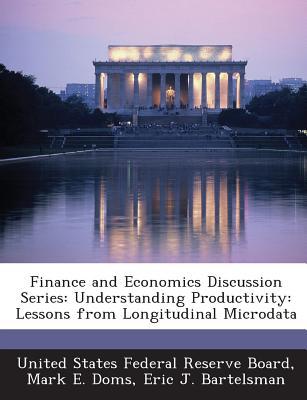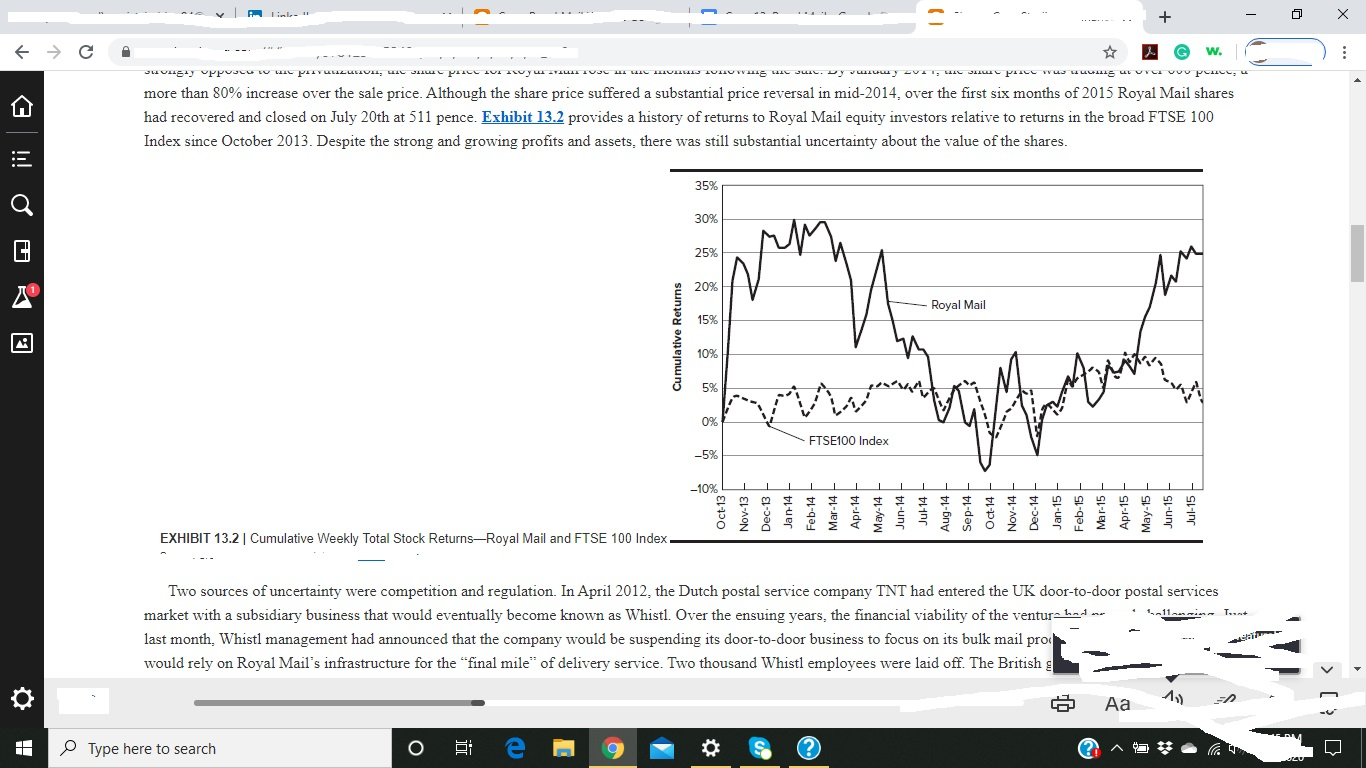
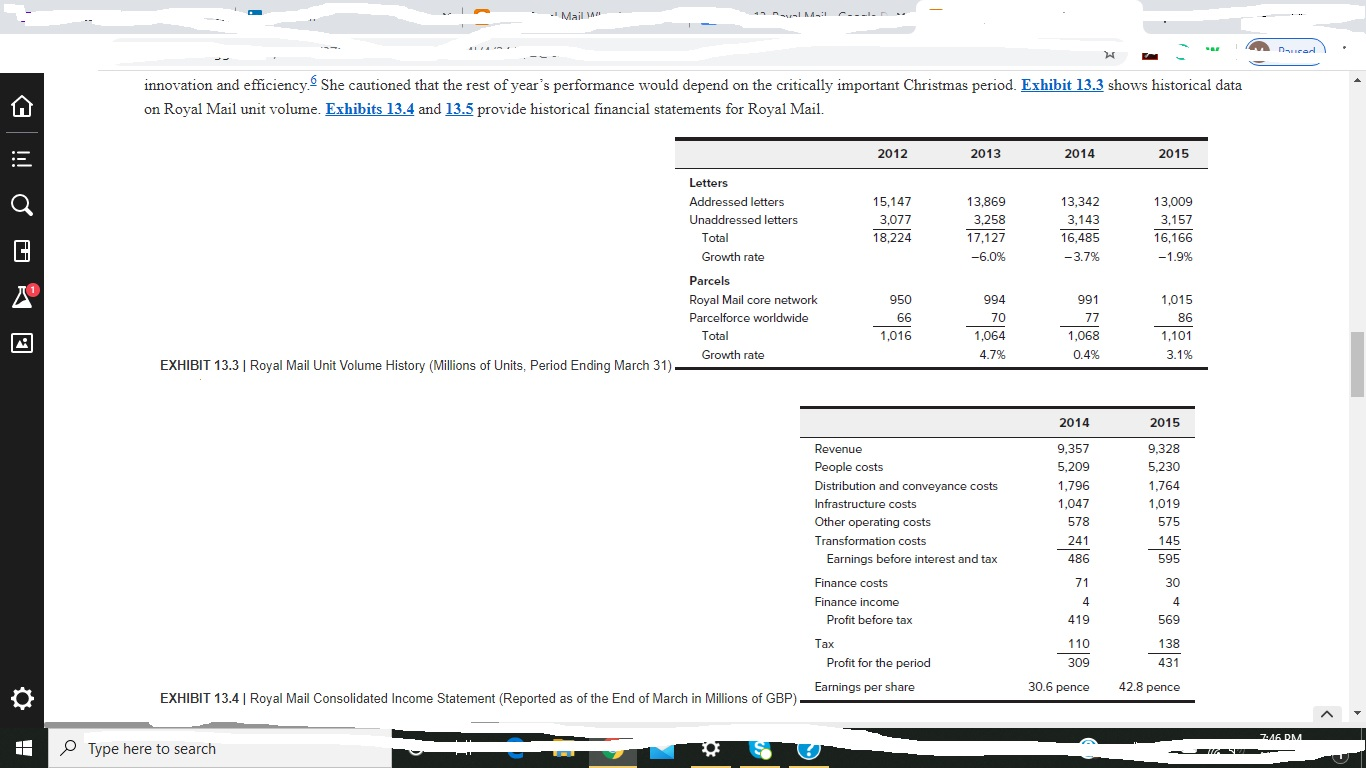
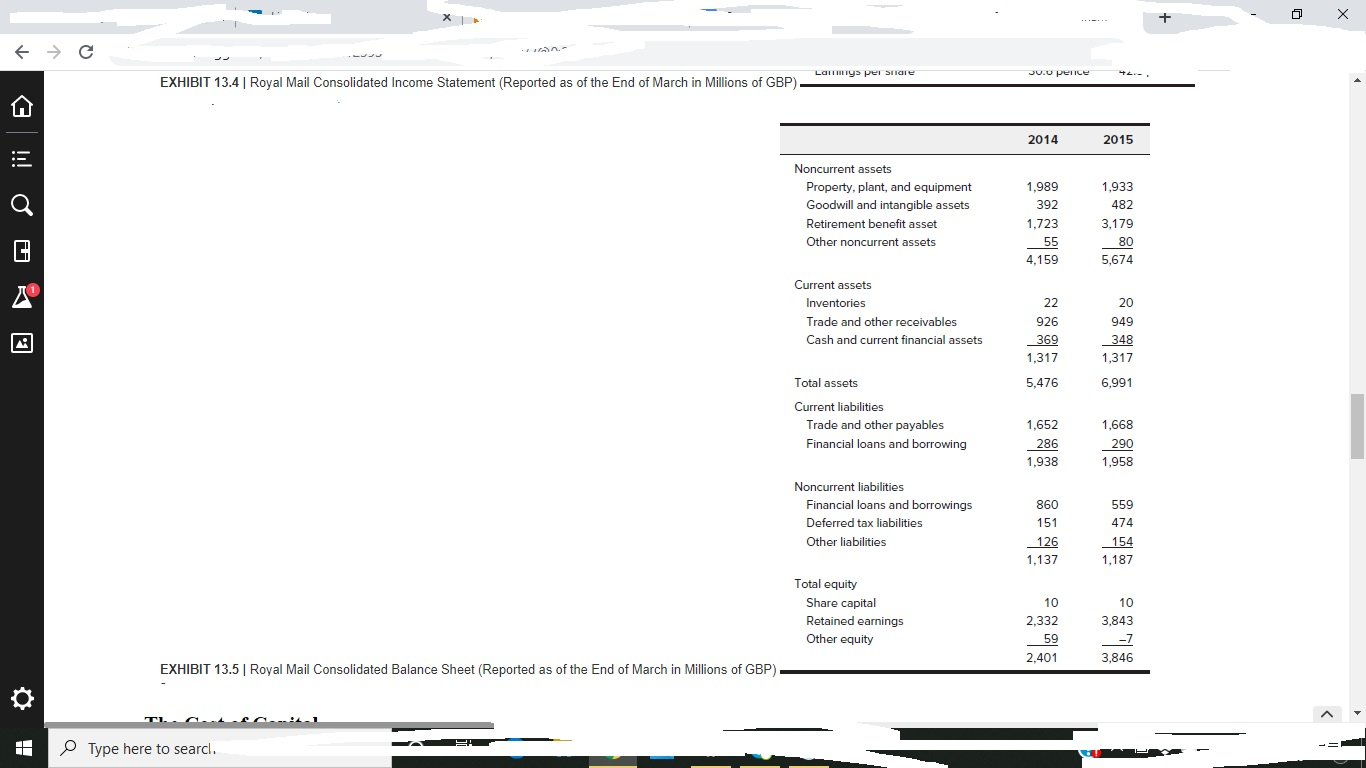

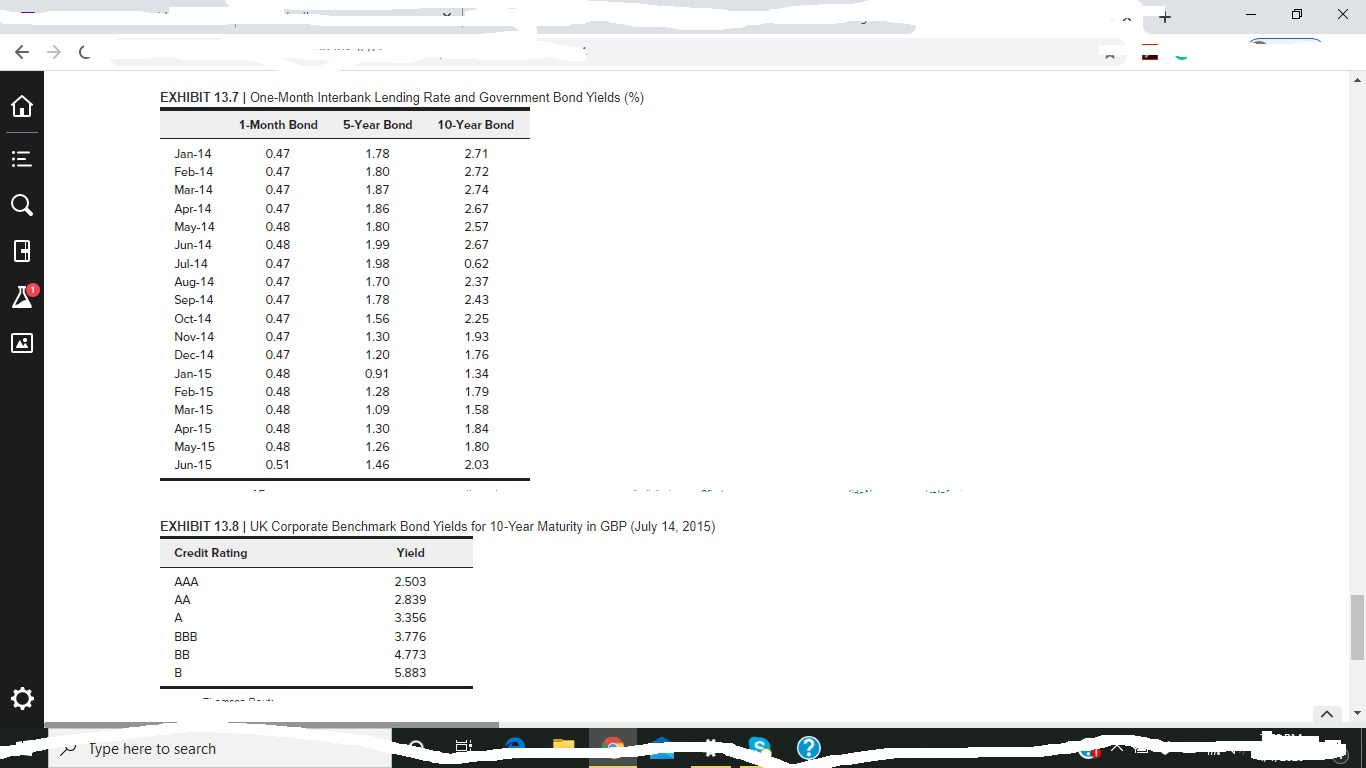
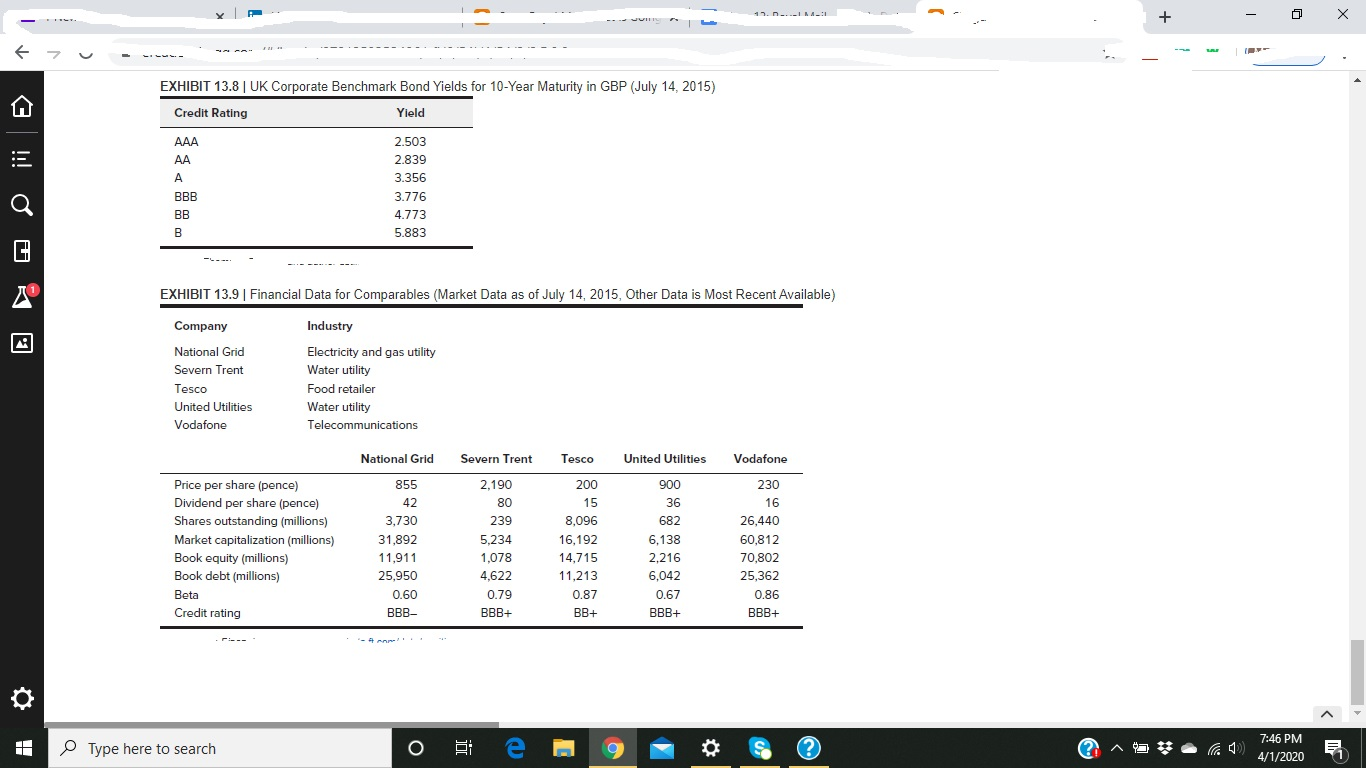
Case 13: Royal Mail
-
What is going on with Hillary Hunt and Royal Mail? Discuss relevant background information and the key issues facing Royal Mail.
-
Why is it important to estimate a firms cost of capital? What does it represent? Is it set by investors or by managers? Who or what determines the cost of capital?
-
What do you think of Kyle Brooks estimate of the WACC? Identify and explain any errors that you feel Kyle Brooks made.
-
Re-estimate the WACC for Royal Mail & the Comparable Firms (Submit the response to Question 4 in Excel)
-
Are the estimates of the WACC for comparable firms helpful to Hillary Hunt? Why?.......
Royal Mail plc: Cost of Capital
As Hillary Hart, senior financial analyst at the British postal service company Royal Mail plc (Royal Mail), approached company headquarters near Blackfriars Bridge in London, she reflected on the momentous nature of the seven years she had spent in that building. During that time, the company had faced important changes in broad demand for letters and parcels, significant restructuring of government regulation, competitive entry into its long-standing monopoly position, deep workforce cuts, wide-scale labor negotiations and strikes, and, lastly, the transition from 500 years as a government-owned enterprise to a massive for-profit company traded on the London Stock Exchange.
Now on July 21, 2015, Hart had an upcoming meeting with several senior managers of the company. Central to the meeting was an evaluation of the cost of capital for Royal Mail. The cost of capital had become a point of discussion for two reasons. First, since privatization, Royal Mail was increasingly looking to shed its government-based decision-making policies of the past for a more market-based orientation. The adoption of an investor-oriented cost-of-capital benchmark provided an important step in moving forward the governance of company investment policy. That said, it was by no means easy to shift company objectives toward rewarding investors and away from a focus on facilitating national employment and communication needs. Second, the company was under an important review by the British regulatory authority, the Office of Communications (Ofcom). Deregulation of private postal services was still very much an experiment in Britain. Due to recent competitive events in the country, Ofcom was reevaluating existing regulatory policies. The cost of capital provided an appropriate benchmark by which to properly assess the profitability of Royal Mails operations and the viability of Royal Mails operations under the existing regulatory policies.
Royal Mail plc
Royal Mail originated in 1516 when King Henry VIII established Sir Brian Tuke as Master of the Posts with the charge to organize a postal service to carry mail between British cities. Throughout its long history, Royal Mail proved to be the worlds Page 198foremost pioneer in postal services. The company introduced many features that became ubiquitous to postal services worldwide. In 1661, the Royal Mail postmaster introduced the first postmark with the declaration [in his own spelling], A stamp is invented that is putt upon every letter shewing the day of the moneth that every letter comes to the office, so that no Letter Carryer may dare detayne a letter from post to post; which before was usual.1 In the late 1700s, Royal Mail was the first postal service to operate a fleet of independent mail coaches and outfit postal carriers in uniforms. In 1840, Royal Mail was the first mail service to offer letter delivery services throughout the entire country for a single rate. To certify postage prepayment in such a system, Royal Mail invented the postage stamp. The original postage stamp, the Penny Black, was a one-penny stamp bearing the face of Queen Victoria (see Exhibit 13.1), and provided prepaid postage for letters of up to half an ounce to be delivered anywhere in Great Britain and Ireland. In recognition of Royal Mails role in developing the first postage stamp, British stamps remained throughout the world as the only postage stamps that did not specify the country of issuance on the stamp. In the mid-19th century, Royal Mail introduced letter boxes where senders could simply deposit letters to be sent with the affixed paid postage.
EXHIBIT 13.1 | The Penny Black, the Worlds First Postage Stamp (Issued in 1840)
Now, due to the dramatic changes in postal services demand at the beginning of the 21st century, it was once again a time for innovation at Royal Mail. In 2006, the British government had removed Royal Mails monopoly status, allowing private companies to compete in collecting and sorting mail in the United Kingdom. With the change, government regulation was reduced, and Royal Mail was freed to set its own postage rates. Over the next six years, Royal Mail responded by increasing the price of First-Class postage from 32 pence to 60 pence.
In 2011, Parliament passed the important Postal Services Act. In this Act, the Postal Services Commission was disbanded and the regulatory purview of postal services in the United Kingdom shifted to the Ofcom. The intent was to dramatically alter the regulation of Royal Mail. Despite the increased liberties, however, the Act designated that Royal Mail was required to maintain six-days-a-week, one-price-goes-anywhere universal service for letters regardless of the ownership structure of the company.
A decision to privatize the British mail service followed a government conclusion that Royal Mail was less efficient and disciplined than many other post offices elsewhere in Europe, and that it urgently needed commercial confidence, capital, and corporate experience to modernize quickly and effectively.2 This need followed a sustained worldwide decline in letter volume in the first decade of the twenty-first century as a result of the substitution of electronic communication. Vince Cable, the UKs Business Secretary, had argued his position before the House of Commons: The governments decision on the sale is practical, it is logical, it is a commercial decision designed to put Royal Mails future in a long-term sustainable business.3 Over the years since deregulation, the financial performance of Royal Mail improved and its operating margin was Page 199up fourfold. Cash flow for the company had grown from negative GBP504 million in fiscal year 2009 to positive GBP282 million in fiscal year 2013.
The privatization of Royal Mail came in October 2013, when the British government sold 60% of its 1 billion shares of Royal Mail to the public for 330 pence each. The transaction generated proceeds of GBP2 billion. Of the shares sold, 73% were sold to institutional investors and 23% were sold to 690,000 individual investors.4
On Royal Mails first day of trading on the London Stock Exchange, its share price rose 38% to 455 pence. Despite high-profile strikes by postal workers who were strongly opposed to the privatization, the share price for Royal Mail rose in the months following the sale. By January 2014, the share price was trading at over 600 pence, a more than 80% increase over the sale price. Although the share price suffered a substantial price reversal in mid-2014, over the first six months of 2015 Royal Mail shares had recovered and closed on July 20th at 511 pence. Exhibit 13.2 provides a history of returns to Royal Mail equity investors relative to returns in the broad FTSE 100 Index since October 2013. Despite the strong and growing profits and assets, there was still substantial uncertainty about the value of the shares.
EXHIBIT 13.2 | Cumulative Weekly Total Stock ReturnsRoyal Mail and FTSE 100 Index
Two sources of uncertainty were competition and regulation. In April 2012, the Dutch postal service company TNT had entered the UK door-to-door postal services market with a subsidiary business that would eventually become known as Whistl. Over the ensuing years, the financial viability of the venture had proved challenging. Just last month, Whistl management had announced that the company would be suspending its door-to-door business to focus on its bulk mail processing service in Britain. It would rely on Royal Mails infrastructure for the final mile of delivery service. Two thousand Whistl employees were laid off. The British government responded by calling into question Ofcoms regulatory policies. In response, Ofcom began a high-profile review of the postal services market in an effort to stimulate competition. One concern was that Royal Mail maintained pricing power in the market such that it could engage in anticompetitive pricing. Such allegations raised the question of what was the appropriate level of profitability for a firm such as Royal Mail.
Moya Greene, CEO of Royal Mail, expressed the companys willingness to fully comply with the review. She also indicated that Royal Mail was facing difficulties of its own but was determined to continue to get better. She specifically stated:
This has been a challenging year. Through a continued focus on efficiency and tight cost control, we have offset the impact of lower than anticipated UK parcel revenue this year, so that operating profit before transformation costs is in line with our expectations. It has also been a year of innovation, with a range of new initiatives delivered at pace. We have introduced around 30 new projects, including services, products and promotions, to improve our customer offering.5
One example was the recent announcement that the company was pursuing an efficiency objective by purchasing 76,000 hand-held scanner devices from Zebra Page 200Technologies. Other initiatives included upstream investment opportunities such as the acquisition of online shopping platforms such as Mallzee and StoreFeeder.
Just that morning, Greene had issued an update on the company performance for the most recent quarter and emphasized substantial success and concerns. She reported that strong performance from the parcels business was offsetting declines in letter delivery revenue, and that the company was committed to investing in innovation and efficiency.6 She cautioned that the rest of years performance would depend on the critically important Christmas period. Exhibit 13.3 shows historical data on Royal Mail unit volume. Exhibits 13.4 and 13.5 provide historical financial statements for Royal Mail.
EXHIBIT 13.3 | Royal Mail Unit Volume History (Millions of Units, Period Ending March 31)
EXHIBIT 13.4 | Royal Mail Consolidated Income Statement (Reported as of the End of March in Millions of GBP) S
EXHIBIT 13.5 | Royal Mail Consolidated Balance Sheet (Reported as of the End of March in Millions of GBP)
The Cost of Capital
The cost of capital was theoretically defined as the prevailing return that investors could earn on alternative investments of similar risk. As such, it was inherently a figure determined by market forces rather than by the company. One attractive feature of the cost of capital was that it provided an opportunity cost benchmark for evaluating investment returns. Business returns that were expected to exceed the cost of capital were considered value creating to investors since the expected returns exceeded what investors could generate on their own with investments of similar risk. Business returns that were expected to be less than the cost of capital were considered value destroying to investors. Moreover, the cost of capital provided an estimate of the fair return for investors in competitive businesses. It was expected that businesses in competitive markets would, on average, earn their cost of capital.
In estimating the cost of capital it was common to consider all capital used in the business. To estimate the opportunity cost of total business capital, it was common to use a weighted average of the prevailing required return values for the various types of investors in the business, such as debt holders and equity holders. This approach was called the weighted average cost of capital (WACC).
In response to the burgeoning interest in a cost of capital estimate for Royal Mail, Hart had asked a colleague, Kyle Brooks, to provide an estimate. Given the unique nature of Royal Mails business and its limited life in public capital markets, Hart recognized that this was not an easy task. Still, Brooks had quickly generated an estimate of 3.828% and provided a stack of documentation. Exhibit 13.6 provides his analysis and summary. Exhibits 13.7 through 13.9 provide his supporting documents.
EXHIBIT 13.6 | Kyle Brookss Cost-of-Capital Analysis
EXHIBIT 13.7 | One-Month Interbank Lending Rate and Government Bond Yields (%)
EXHIBIT 13.8 | UK Corporate Benchmark Bond Yields for 10-Year Maturity in GBP (July 14, 2015)
EXHIBIT 13.9 | Financial Data for Comparables (Market Data as of July 14, 2015, Other Data is Most Recent Available)
- - - ........ + - X w. DUHET PPOscu w W PELLULIOL, DEPEC 201 cuyas Y VOC WIC ILLOLLE TUU was Ju. Dyna-VT, I Puce W F -5 L vrevov Pous, more than 80% increase over the sale price. Although the share price suffered a substantial price reversal in mid-2014, over the first six months of 2015 Royal Mail shares had recovered and closed on July 20th at 511 pence. Exhibit 13.2 provides a history of returns to Royal Mail equity investors relative to returns in the broad FTSE 100 Index since October 2013. Despite the strong and growing profits and assets, there was still substantial uncertainty about the value of the shares. !!! O Royal Mail Cumulative Returns FTSE100 Index -10% Oct-13 Nov-13 Dec-13 Jan-14 Feb-14 Mar-14 Apr-14 May-14 Jun-14 Jul14 Aug-14 Sep-14 Jul-15 Feb- EXHIBIT 13.2 Cumulative Weekly Total Stock ReturnsRoyal Mail and FTSE 100 Index Two sources of uncertainty were competition and regulation. In April 2012, the Dutch postal service company TNT had entered the UK door-to-door postal services market with a subsidiary business that would eventually become known as Whistl. Over the ensuing years, the financial viability of the venture had 11. Test last month. Whistl management had announced that the company would be suspending its door-to-door business to focus on its bulk mail pro would rely on Royal Mail's infrastructure for the "final mile" of delivery service. Two thousand Whistl employees were laid off. The British g Aa 1,1 . Type here to search o e 9 - 6 Mail innovation and efficiency. She cautioned that the rest of year's performance would depend on the critically important Christmas period. Exhibit 13.3 shows historical data on Royal Mail unit volume. Exhibits 13.4 and 13.5 provide historical financial statements for Royal Mail. 2012 2013 2014 2015 13,342 Oro O jie Letters Addressed letters Unaddressed letters Total Growth rate 15,147 3,077 18,224 13,869 3,258 17,127 -6.0% 3,143 13,009 3,157 16,166 -1.9% 16,485 -3.7% 994 991 1,015 Parcels Royal Mail core network Parcelforce worldwide Total Growth rate 950 66 1,016 70 77 1,064 1,068 0.4% 1,101 3.1% 4.7% EXHIBIT 13.3 Royal Mail Unit Volume History (Millions of Units, Period Ending March 31) 2014 2015 9,357 5,209 1,796 1,047 9,328 5,230 1,764 1,019 575 145 578 241 Revenue People costs Distribution and conveyance costs Infrastructure costs Other operating costs Transformation costs Earnings before interest and tax Finance costs Finance income Profit before tax Tax Profit for the period 595 569 110 138 431 42.8 pence Earnings per share 30.6 pence EXHIBIT 13.4 | Royal Mail Consolidated Income Statement (Reported as of the End of March in Millions of GBP) - 7446 DM Type here to search Lanys per llare JU.U pence4 2.- EXHIBIT 13.4 Royal Mail Consolidated Income Statement (Reported as of the End of March in Millions of GBP) - 2014 2015 !!! O o Noncurrent assets Property, plant, and equipment Goodwill and intangible assets Retirement benefit asset Other noncurrent assets 1,989 392 1,723 55 4,159 1,933 482 3,179 5,674 22 Current assets Inventories Trade and other receivables Cash and current financial assets 926 369 20 949 348 1,317 6,991 1,317 5,476 Total assets Current liabilities Trade and other payables Financial loans and borrowing 1,652 286 1,938 1,668 290 1,958 860 Noncurrent liabilities Financial loans and borrowings Deferred tax liabilities Other liabilities 559 474 151 126 154 1,137 1,187 10 10 Total equity Share capital Retained earnings Other equity 3,843 2,332 59 2,401 --7 3,846 EXHIBIT 13.5 Royal Mail Consolidated Balance Sheet (Reported as of the End of March in Millions of GBP) Type here to search. x in - X 2 W. EXHIBIT 13.6 Kyle Brooks's Cost-of-Capital Analysis TO: FROM: DATE: SUBJECT: Hillary Hart Kyle Brooks July 17, 2015 RM's cost of capital Based on the following assumptions, my estimate of Royal Mail's cost of capital is 3.828%. Capital Structure Since Royal Mail is funded with both debt and equity, I used the weighted average cost of capital (WACC) method. Based on the March 2015 balance sheet, current debt as a proportion of total capital makes up 6%, noncurrent debt as a proportion of total capital makes up 12%, and equity accounts for 82%: Capital Sources Book Values (in millions of GBP) Current debt Noncurrent debt Equity 290 559 3,846 6 % of total capital 12% of total capital 82% of total capital Cost of Debt My estimate of Royal Mail's cost of debt was 3.188%, which is the weighted average between the 0.9% rate Royal Mail is paying on its current debt and the 4.375% rate it is paying on its noncurrent debt. For the noncurrent debt rate I used the coupon rate from a recent bond. On July 29, 2014, Royal Mail issued a 10-year bond with an annual coupon of 4.375%. The bond was rated by S&P at BBB. S&P recently reaffirmed that rating, and the bond is currently trading at a price of 106. I used a tax rate of 20%, which is the marginal tax rate for similar corporations in the United Kingdom, to estimate the after-tax cost of debt. Cost of Equity I estimated the cost of equity at 4.11% based on the prevailing dividend yield for Royal Mail. This was calculated by dividing last year's dividend of 21 pence by the current share price of 511 pence. The dividend yield is a good estimate of the cost of equity because it indicates exactly what equity holders received over the past year on their investment. 0 I also looked at an estimate based on the capital-asset-pricing model (CAPM). My CAPM estimate of Royal Mail's cost of equity was 5.321%. To get this number, I used a risk-free rate of 1.551%, the average yield on the 5-year government bond over the past 18 months. Because of the short period since Royal Mail has been privatized, there were few estimates of beta. But recently the equity research firm Chambers and Thompson published a beta estimate for Roval Mail of 0.65 solused that. For my market risk premium lused 5.8%. This estimate comes from a Type here to search OP e S ? + - 0 X EXHIBIT 13.7 | One-Month Interbank Lending Rate and Government Bond Yields (%) 1-Month Bond 5-Year Bond 10-Year Bond 0.47 0.47 2.71 2.72 2.74 !!! O o 0.47 0.47 0.48 0.48 0.47 0.47 2.67 2.57 2.67 0.62 2.37 2.43 Jan-14 Feb-14 Mar-14 Apr-14 May-14 Jun-14 Jul-14 Aug-14 Sep-14 Oct-14 Nov-14 Dec-14 Jan-15 Feb-15 Mar-15 Apr-15 May-15 Jun-15 1.78 1.80 1.87 1.86 1.80 1.99 1.98 1.70 1.78 1.56 1.30 1.20 0.91 1.28 1.09 1.30 1.26 1.46 2.25 1.93 0.47 0.47 0.47 0.48 0.48 0.48 0.48 0.48 0.51 1.76 1.34 1.79 1.58 1.84 1.80 2.03 EXHIBIT 13.8 UK Corporate Benchmark Bond Yields for 10-Year Maturity in GBP (July 14, 2015) Credit Rating Yield AAA AA 2.503 2.839 3.356 3.776 4.773 5.883 Type here to search - + - 0 x EXHIBIT 13.8 | UK Corporate Benchmark Bond Yields for 10-Year Maturity in GBP (July 14, 2015) Credit Rating Yield AAA !!! O 2.503 2.839 3.356 3.776 4.773 5.883 BBB BB o EXHIBIT 13.9 Financial Data for Comparables (Market Data as of July 14, 2015, Other Data is Most Recent Available) Industry Company National Grid Severn Trent Tesco United Utilities Vodafone Electricity and gas utility Water utility Food retailer Water utility Telecommunications National Grid Severn Trent Tesco United Utilities Vodafone 855 200 42 15 Price per share (pence) Dividend per share (pence) Shares outstanding (millions) Market capitalization (millions) Book equity (millions) Book debt (millions) Beta Credit rating 3,730 31,892 11,911 25,950 0.60 BBB- 2,190 80 239 5,234 1,078 4,622 0.79 BBB+ 8,096 16,192 14,715 11,213 0.87 900 36 682 6,138 2,216 6,042 0.67 BBB+ 230 16 26,440 60,812 70,802 25,362 0.86 BBB+ BB+ Type here to search o Be 9 0 7:46 PM 4/1/2020 - - - ........ + - X w. DUHET PPOscu w W PELLULIOL, DEPEC 201 cuyas Y VOC WIC ILLOLLE TUU was Ju. Dyna-VT, I Puce W F -5 L vrevov Pous, more than 80% increase over the sale price. Although the share price suffered a substantial price reversal in mid-2014, over the first six months of 2015 Royal Mail shares had recovered and closed on July 20th at 511 pence. Exhibit 13.2 provides a history of returns to Royal Mail equity investors relative to returns in the broad FTSE 100 Index since October 2013. Despite the strong and growing profits and assets, there was still substantial uncertainty about the value of the shares. !!! O Royal Mail Cumulative Returns FTSE100 Index -10% Oct-13 Nov-13 Dec-13 Jan-14 Feb-14 Mar-14 Apr-14 May-14 Jun-14 Jul14 Aug-14 Sep-14 Jul-15 Feb- EXHIBIT 13.2 Cumulative Weekly Total Stock ReturnsRoyal Mail and FTSE 100 Index Two sources of uncertainty were competition and regulation. In April 2012, the Dutch postal service company TNT had entered the UK door-to-door postal services market with a subsidiary business that would eventually become known as Whistl. Over the ensuing years, the financial viability of the venture had 11. Test last month. Whistl management had announced that the company would be suspending its door-to-door business to focus on its bulk mail pro would rely on Royal Mail's infrastructure for the "final mile" of delivery service. Two thousand Whistl employees were laid off. The British g Aa 1,1 . Type here to search o e 9 - 6 Mail innovation and efficiency. She cautioned that the rest of year's performance would depend on the critically important Christmas period. Exhibit 13.3 shows historical data on Royal Mail unit volume. Exhibits 13.4 and 13.5 provide historical financial statements for Royal Mail. 2012 2013 2014 2015 13,342 Oro O jie Letters Addressed letters Unaddressed letters Total Growth rate 15,147 3,077 18,224 13,869 3,258 17,127 -6.0% 3,143 13,009 3,157 16,166 -1.9% 16,485 -3.7% 994 991 1,015 Parcels Royal Mail core network Parcelforce worldwide Total Growth rate 950 66 1,016 70 77 1,064 1,068 0.4% 1,101 3.1% 4.7% EXHIBIT 13.3 Royal Mail Unit Volume History (Millions of Units, Period Ending March 31) 2014 2015 9,357 5,209 1,796 1,047 9,328 5,230 1,764 1,019 575 145 578 241 Revenue People costs Distribution and conveyance costs Infrastructure costs Other operating costs Transformation costs Earnings before interest and tax Finance costs Finance income Profit before tax Tax Profit for the period 595 569 110 138 431 42.8 pence Earnings per share 30.6 pence EXHIBIT 13.4 | Royal Mail Consolidated Income Statement (Reported as of the End of March in Millions of GBP) - 7446 DM Type here to search Lanys per llare JU.U pence4 2.- EXHIBIT 13.4 Royal Mail Consolidated Income Statement (Reported as of the End of March in Millions of GBP) - 2014 2015 !!! O o Noncurrent assets Property, plant, and equipment Goodwill and intangible assets Retirement benefit asset Other noncurrent assets 1,989 392 1,723 55 4,159 1,933 482 3,179 5,674 22 Current assets Inventories Trade and other receivables Cash and current financial assets 926 369 20 949 348 1,317 6,991 1,317 5,476 Total assets Current liabilities Trade and other payables Financial loans and borrowing 1,652 286 1,938 1,668 290 1,958 860 Noncurrent liabilities Financial loans and borrowings Deferred tax liabilities Other liabilities 559 474 151 126 154 1,137 1,187 10 10 Total equity Share capital Retained earnings Other equity 3,843 2,332 59 2,401 --7 3,846 EXHIBIT 13.5 Royal Mail Consolidated Balance Sheet (Reported as of the End of March in Millions of GBP) Type here to search. x in - X 2 W. EXHIBIT 13.6 Kyle Brooks's Cost-of-Capital Analysis TO: FROM: DATE: SUBJECT: Hillary Hart Kyle Brooks July 17, 2015 RM's cost of capital Based on the following assumptions, my estimate of Royal Mail's cost of capital is 3.828%. Capital Structure Since Royal Mail is funded with both debt and equity, I used the weighted average cost of capital (WACC) method. Based on the March 2015 balance sheet, current debt as a proportion of total capital makes up 6%, noncurrent debt as a proportion of total capital makes up 12%, and equity accounts for 82%: Capital Sources Book Values (in millions of GBP) Current debt Noncurrent debt Equity 290 559 3,846 6 % of total capital 12% of total capital 82% of total capital Cost of Debt My estimate of Royal Mail's cost of debt was 3.188%, which is the weighted average between the 0.9% rate Royal Mail is paying on its current debt and the 4.375% rate it is paying on its noncurrent debt. For the noncurrent debt rate I used the coupon rate from a recent bond. On July 29, 2014, Royal Mail issued a 10-year bond with an annual coupon of 4.375%. The bond was rated by S&P at BBB. S&P recently reaffirmed that rating, and the bond is currently trading at a price of 106. I used a tax rate of 20%, which is the marginal tax rate for similar corporations in the United Kingdom, to estimate the after-tax cost of debt. Cost of Equity I estimated the cost of equity at 4.11% based on the prevailing dividend yield for Royal Mail. This was calculated by dividing last year's dividend of 21 pence by the current share price of 511 pence. The dividend yield is a good estimate of the cost of equity because it indicates exactly what equity holders received over the past year on their investment. 0 I also looked at an estimate based on the capital-asset-pricing model (CAPM). My CAPM estimate of Royal Mail's cost of equity was 5.321%. To get this number, I used a risk-free rate of 1.551%, the average yield on the 5-year government bond over the past 18 months. Because of the short period since Royal Mail has been privatized, there were few estimates of beta. But recently the equity research firm Chambers and Thompson published a beta estimate for Roval Mail of 0.65 solused that. For my market risk premium lused 5.8%. This estimate comes from a Type here to search OP e S ? + - 0 X EXHIBIT 13.7 | One-Month Interbank Lending Rate and Government Bond Yields (%) 1-Month Bond 5-Year Bond 10-Year Bond 0.47 0.47 2.71 2.72 2.74 !!! O o 0.47 0.47 0.48 0.48 0.47 0.47 2.67 2.57 2.67 0.62 2.37 2.43 Jan-14 Feb-14 Mar-14 Apr-14 May-14 Jun-14 Jul-14 Aug-14 Sep-14 Oct-14 Nov-14 Dec-14 Jan-15 Feb-15 Mar-15 Apr-15 May-15 Jun-15 1.78 1.80 1.87 1.86 1.80 1.99 1.98 1.70 1.78 1.56 1.30 1.20 0.91 1.28 1.09 1.30 1.26 1.46 2.25 1.93 0.47 0.47 0.47 0.48 0.48 0.48 0.48 0.48 0.51 1.76 1.34 1.79 1.58 1.84 1.80 2.03 EXHIBIT 13.8 UK Corporate Benchmark Bond Yields for 10-Year Maturity in GBP (July 14, 2015) Credit Rating Yield AAA AA 2.503 2.839 3.356 3.776 4.773 5.883 Type here to search - + - 0 x EXHIBIT 13.8 | UK Corporate Benchmark Bond Yields for 10-Year Maturity in GBP (July 14, 2015) Credit Rating Yield AAA !!! O 2.503 2.839 3.356 3.776 4.773 5.883 BBB BB o EXHIBIT 13.9 Financial Data for Comparables (Market Data as of July 14, 2015, Other Data is Most Recent Available) Industry Company National Grid Severn Trent Tesco United Utilities Vodafone Electricity and gas utility Water utility Food retailer Water utility Telecommunications National Grid Severn Trent Tesco United Utilities Vodafone 855 200 42 15 Price per share (pence) Dividend per share (pence) Shares outstanding (millions) Market capitalization (millions) Book equity (millions) Book debt (millions) Beta Credit rating 3,730 31,892 11,911 25,950 0.60 BBB- 2,190 80 239 5,234 1,078 4,622 0.79 BBB+ 8,096 16,192 14,715 11,213 0.87 900 36 682 6,138 2,216 6,042 0.67 BBB+ 230 16 26,440 60,812 70,802 25,362 0.86 BBB+ BB+ Type here to search o Be 9 0 7:46 PM 4/1/2020












